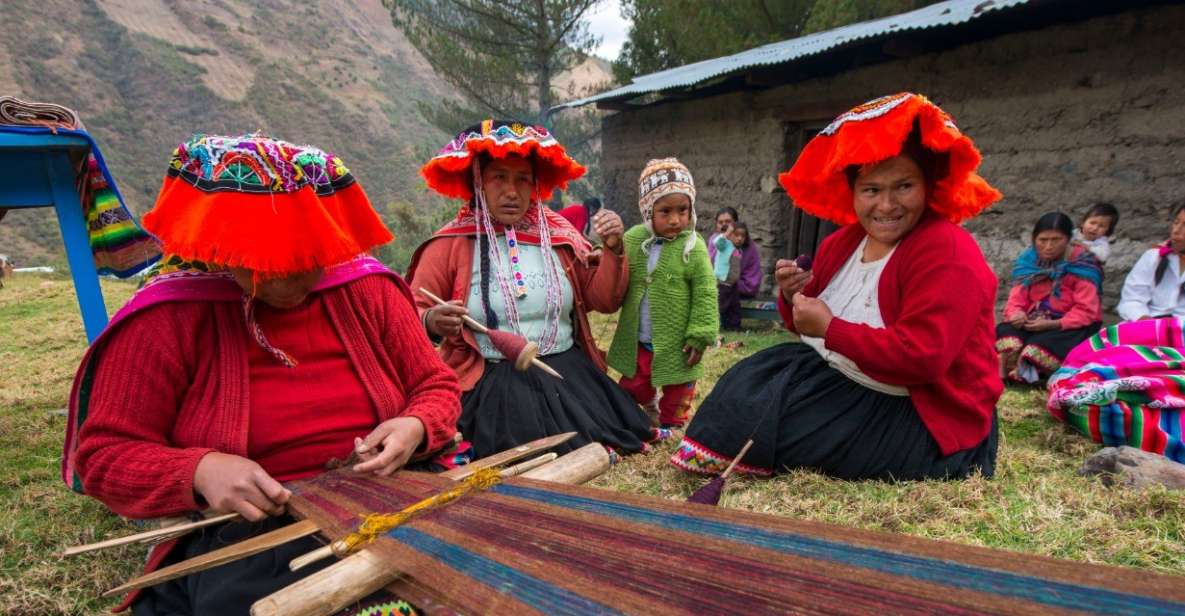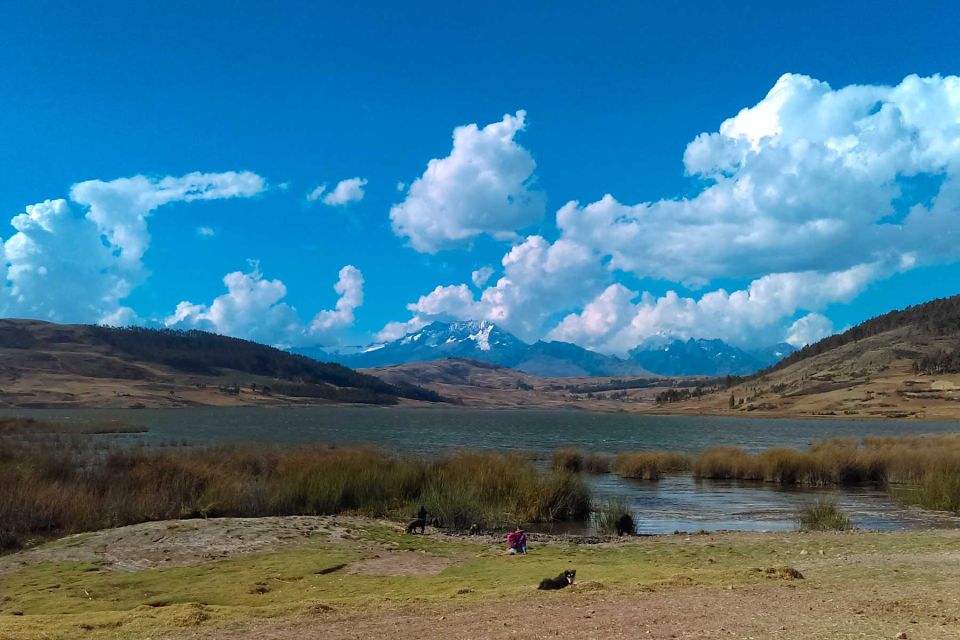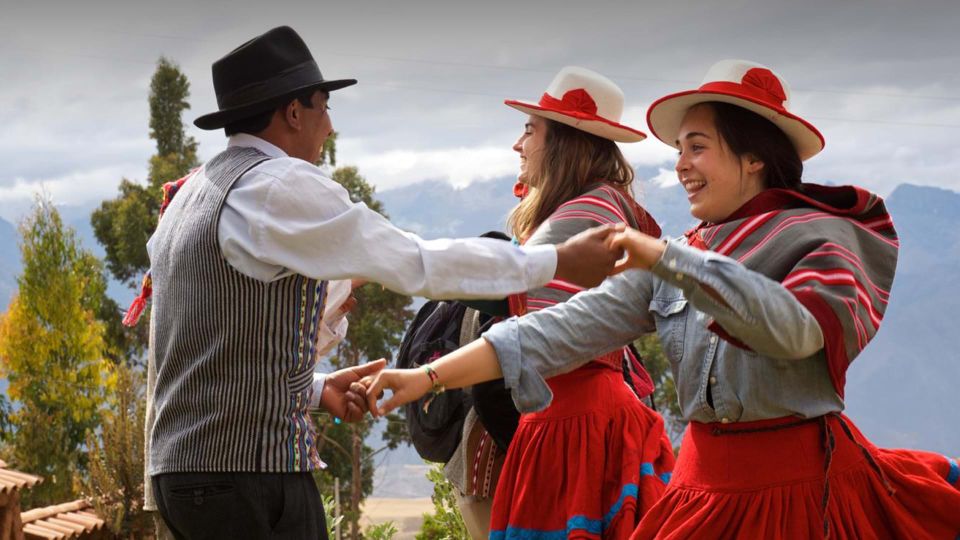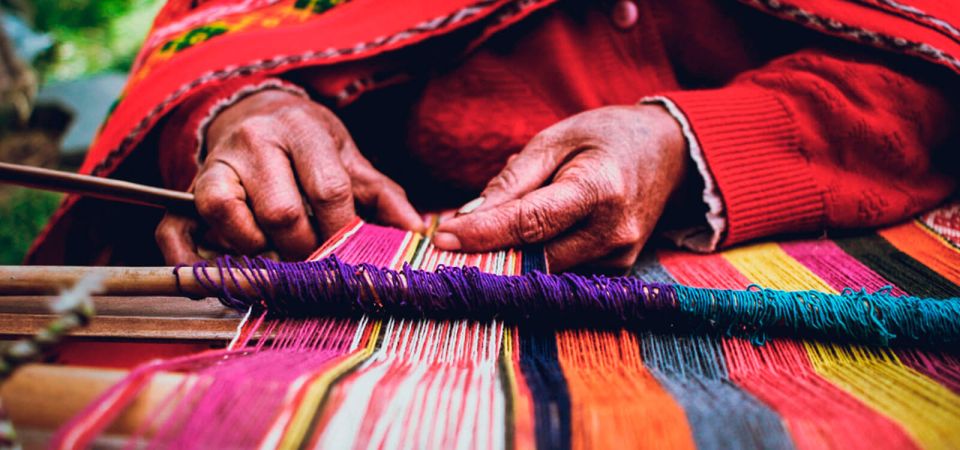The experience of rural community-based tourism in Chinchero offers a fascinating glimpse into the heart of the Sacred Valley, where travelers can engage directly with local artisans and their time-honored traditions. By participating in activities like traditional weaving and agrotourism, visitors not only appreciate Chinchero’s stunning landscapes but also forge meaningful connections with its residents. This unique approach to tourism emphasizes sustainability and cultural preservation, prompting questions about the impact of such initiatives on both the community and the environment. What unfolds in this vibrant interplay between visitors and locals might just reshape their understanding of travel itself.
Key Points

- Chinchero offers visitors an immersive experience in local culture through interactions with artisans and traditional weaving practices.
- The stunning landscapes of the Sacred Valley enhance the rural tourism experience, with terraced fields and majestic mountains.
- Engaging in agrotourism activities allows visitors to learn about sustainable agriculture and local farming practices.
- Cultural depth is added through spiritual walks and traditional receptions featuring music and dance, fostering community connections.
- A focus on sustainable tourism benefits both visitors and the local community, promoting cultural heritage and environmental stewardship.
Overview of Chinchero Experience

Exploring the rural community-based tourism experience in Chinchero offers travelers a unique glimpse into the rich cultural heritage and stunning landscapes of the Andes. Nestled in the Sacred Valley, Chinchero isn’t just a destination; it’s a vibrant community where ancient traditions come alive.
Visitors engage with local artisans, witnessing the intricate weaving techniques passed down through generations. The breathtaking scenery, including terraced fields and majestic mountains, provides a perfect backdrop for immersive experiences.
This one-day journey allows travelers to connect deeply with the local culture while enjoying sustainable practices in agriculture. With a focus on community involvement, it enriches both visitors and residents, fostering a genuine exchange that celebrates Chinchero’s unique identity and heritage.
You can also read our reviews of more tours and experiences in Andes Mountains Peru.
Itinerary Highlights

The itinerary for the rural community-based tourism experience in Chinchero promises an enriching day filled with cultural interactions and breathtaking views.
Participants start their journey with a convenient hotel pickup, followed by a visit to the archaeological center of Chinchero. They’re welcomed by locals in traditional dress, accompanied by lively music.
Engaging in agrotourism activities, travelers learn about local agricultural products and tools. A short walk to offer gratitude to Pachamama adds a spiritual touch.
The itinerary also includes a visit to a viewpoint overlooking Piuray Lagoon, where myths come alive. After enjoying free time for a meal made from local ingredients, participants interact with community members and observe textile artisans before returning to Cusco.
Included Services

Included in the experience are essential services designed to ensure a smooth and enriching journey for every participant.
A briefing one day prior to the excursion helps everyone prepare.
With a small group size, travelers enjoy a personalized experience led by a professional guide fluent in both English and Spanish.
Tourist transportation is provided, ensuring comfortable transfers from hotels to Ollantaytambo and back.
Plus, the entrance ticket for the archaeological center of Ollantaytambo is included, allowing participants to fully enjoy the local culture and history.
Necessary materials for activities are also covered, making it easy for everyone to engage in the planned agrotourism activities.
These included services contribute significantly to the overall experience in Chinchero.
Exclusions
While participants enjoy a range of included services, it’s important to note that certain costs, like meals not mentioned in the itinerary and personal expenses, aren’t covered in the experience.
Travelers should be aware that they’ll need to budget for any food they choose to purchase outside of the planned meals. Plus, expenses such as handicrafts, drinks, and tips are personal choices. While tips are voluntary, they reflect the level of service received.
It’s wise for participants to plan accordingly, ensuring they’ve enough funds to fully enjoy their day in Chinchero without any unexpected financial strain. Understanding these exclusions allows for a more enjoyable and stress-free experience in this vibrant community.
More Great Tours NearbyImportant Information
Travelers should keep in mind some important considerations to ensure a smooth and enjoyable experience during their rural community-based tourism adventure in Chinchero.
It’s essential to bring a valid passport or ID card, as well as biodegradable sunscreen and insect repellent to protect both skin and the environment.
Participants should also be in adequate health, as some activities may require physical exertion.
Wearing comfortable shoes is a must for exploring the archaeological sites and engaging in agrotourism activities.
Lastly, travelers should be mindful of personal expenses, as food and handicrafts aren’t included in the package.
- || Tour + Hotel || Cusco and Machu Picchu 5 Days 4 Nights
- Cusco – Rainbow Mountain and Machu Picchu in 5 Days + Hotel 3
- Cusco, City Tour and Machu Picchu 3 Days || 4-Star Hotel ||
- Private Chocolate Tour in Huayopata
- 9 Days Excursion Cusco, Sacred Valley, Lake Titicaca || Hotel
- From Cusco: Trekking to Choquequirao 4 Days/3 Nights With Meal
Community Engagement
Community engagement is at the heart of the rural tourism experience in Chinchero, fostering meaningful connections between visitors and local residents. This vibrant interaction helps travelers gain insights into the daily lives, traditions, and customs of the community.
Visitors participate in agrotourism activities, learning about local agricultural practices and the tools used. They also enjoy traditional receptions featuring music and dance, which enriches their understanding of the culture.
On top of that, engaging with local artisans provides an authentic glimpse into the craftsmanship of Chinchero. These experiences not only enhance the visitor’s journey but also empower the community, creating a sustainable model that benefits everyone involved.
Through such engagement, both visitors and locals share stories, making memories that last a lifetime.
Cultural Significance
The cultural significance of Chinchero extends beyond its stunning landscapes, as it embodies a rich tapestry of traditions, beliefs, and practices that are deeply intertwined with the daily lives of its residents.
The community’s vibrant textiles, often created through ancient techniques, reflect not only artistic expression but also the historical identity of the people.
Traditional ceremonies, like offerings to Pachamama, showcase a profound respect for nature and spirituality.
The stories surrounding local landmarks, such as the Piuray Lagoon, reveal age-old myths that connect the community to its ancestors.
Engaging with these cultural elements allows visitors to appreciate the depth of Chinchero’s heritage, fostering a greater understanding and appreciation for the rural way of life that thrives in this unique region.
Practical Tips for Travelers

When planning a trip to Chinchero, it’s essential to pack wisely to fully enjoy the rural community-based tourism experience.
Travelers should bring a valid passport or ID, biodegradable sunscreen, and insect repellent to protect both themselves and the environment.
Comfortable walking shoes are a must for exploring the archaeological sites and rural landscapes.
It’s also wise to carry a reusable water bottle to stay hydrated while minimizing plastic waste.
Don’t forget to bring cash for personal expenses like local handicrafts and tips, as these aren’t included in the tour price.
Lastly, having a small backpack for essentials can make the day more enjoyable.
With these tips, travelers can enjoy Chinchero’s rich culture and natural beauty.
Frequently Asked Questions
What Is the Best Time of Year to Visit Chinchero?
The best time to visit Chinchero is during the dry season, from May to September. Visitors enjoy pleasant weather, stunning landscapes, and vibrant local festivals, making it an ideal period for exploration and culture.
Are Children Allowed to Participate in the Tour?
Yes, children can participate in the tour. The experience’s designed for families, ensuring engaging activities that cater to all ages, allowing kids to learn about local culture while enjoying a fun day in Chinchero.
Is There an Age Limit for Participants?
There isn’t a specific age limit for participants, but those in adequate health can enjoy the experience. It’s recommended that families consider the activities when deciding if children will fully engage in the tour.
Can Dietary Restrictions Be Accommodated During Lunch?
Dietary restrictions can often be accommodated during lunch. Participants should inform the organizer beforehand, ensuring the meal meets individual needs and preferences, allowing everyone to enjoy the local flavors without worry.
What Is the Cancellation Policy for Last-Minute Changes?
The cancellation policy allows free cancellation up to 24 hours before the experience. If changes are needed last minute, participants should contact the provider directly to explore possible options, ensuring flexibility in their travel plans.
Recap
To sum it up, the rural community-based tourism experience in Chinchero offers travelers a chance to connect deeply with local culture and traditions.
By engaging in hands-on activities and exploring the breathtaking landscapes, visitors leave with a greater appreciation for the vibrant heritage of the Sacred Valley.
This immersive journey not only supports sustainable practices but also fosters lasting relationships between travelers and the community, making it a truly enriching adventure for all involved.
You can check availability for your dates here:More Tour Reviews in Andes Mountains Peru
Not for you? Here's more nearby things to do in Andes Mountains Peru we have reviewed
- 25 Best Tours In Andes Mountains Peru
- 9 Best Private Tours In Andes Mountains Peru
- 6 Best Lunch Experiences In Andes Mountains Peru
- 14 Best Treks And Hiking Tours In Andes Mountains Peru
- 2 Best Buffet Experiences In Andes Mountains Peru
- 8 Best 4 Day Tours In Andes Mountains Peru
- 8 Best 3 Day Tours In Andes Mountains Peru
- 3 Best City Tours In Andes Mountains Peru
- 20 Best Private Drivers In Andes Mountains Peru
- 8 Best 2 Day Tours In Andes Mountains Peru
- 2 Best Bike Tours In Andes Mountains Peru
- 4 Best Full-Day Tours In Andes Mountains Peru
